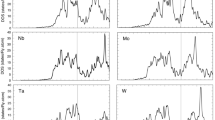Abstract
The contributions at a temperature of 500 and 600 K of the chemical, elastic, vibrational, magnetic, electronic, and configurational energies to the Gibbs energy of mixing of bcc alloys without regard for the contribution of a short-range order are calculated as functions of composition and temperature using physical–empirical models. The temperature dependences of the heat capacity of an alloy in both one- and twophase states are calculated. The heat capacity jumps calculated for alloys of various compositions can be used to estimate the equilibrium solubility boundaries of Fe–Cr alloys, which can hardly be found from experimental data because of the slow diffusion processes that occur when an equilibrium state is reached. The calculated solubility boundary of bcc solid solutions and the spinodal and the heat capacity of Fe–Cr alloys are compared with the experimental data and the calculation results obtained in other works. The agreement and discrepancy between these data are discussed.
Similar content being viewed by others
References
A. L. Udovskii and D. A. Vasil’ev, “Application of physical–empirical models to calculate a fragment of the phase diagram and the physical properties of bcc Fe–Cr alloys: I. Formulation of a model and the estimation and approximation of experimental data,” Russian Metallurgy (Metally), No. 3, 247–254 (2015).
G. Wranglen, An Introduction to Corrosion and Protection of Metals (Chapman and Hall, New York, 1985).
I. Mirebeau et al., “First measurement of short-rangeorder inversion as a fraction of concentration in a transition alloy,” Phys. Rev. Lett. 53 (7), 687–690 (1984).
I. Mirebeau and G. Parette, “Neutron study of the short-range-order inversion in Fe(1–x)Cr(x),” Phys. Rev. B 82, 104203 (2010).
A. A. Mirzoev, M. M. Yalalov, and D. A. Mirzaev, “Calculation of the energy of mixing for the Fe–Cr Alloys by the first-principles methods of computer simulation,” Phys. Met. Metallogr. 97 (4), 336–343 (2004).
P. Olsson et al., “Ab initio formation energies of Fe–Cr alloys,” JNM 321, 84–90 (2003).
P. Olsson et al., “Two-band modeling of a-prime phase formation in Fe–Cr,” Phys. Rev. B 72, 214119 (2005).
P. A. Korzhavyi and A. V. Ruban, “Electronic structure and effective chemical and magnetic exchange interactions in bcc Fe–Cr alloys,” Phys. Rev. B 79, 054202 (2009).
A. V. Ruban and V. I. Razumovsky, “First-principles based thermodynamic model of phase equilibria in bcc Fe–Cr alloys,” Phys. Rev. B 86, 174111 (2012).
O. O. Kubashewski and S. B. Olkokk, Metallurgical Thermochemistry (Springer, Berlin, 1979).
R. O. Williams and H. W. Paxton, “The nature of aging of binary iron-chromium alloys around 500°C,” J. Iron Steel Inst., March, 358–374 (1957).
A. Caro, “The computational modeling of alloys: from ab initio and thermodynamics to heterogeneous precipitation,” in Mater. Generat. IV Rectors (NATO Advanced Study Institute Cargese, 2007), Vol.6.
R. N. Hajra et al., “Thermodynamic stability of Fe–Cr binary system: The crucial role of magnetic contribution as elucidated by calorimetric measurements,” Advanc. Mater. Res. 794, 468–475 (2013).
A. L. Udovskii, “Computer simulation of the phase diagrams, the thermodynamic properties, and the structure of multicomponent systems,” Izv. Ross. Akad. Nauk, Ser. Met., No. 2, 136–157 (1990).
A. L. Udovskii, “Physical fundamentals of computer designing of materials,” in Physical Metallurgy: Manual, Ed. by B. A. Kalin (MIFI, Moscow, 2012), Vol. 4, Chapter 15.
S. C. Chapra and R. P. Canale, Numerical Methods for Engineers, 6th Edition (McGraw-Hill, New York, 2010).
W. Xiong, P. Hedstrom, M. Selleby, J. Odqvist, M. Thuvander, and Q. Chen, “An improved thermodynamic modeling of the Fe–Cr system down to zero Kelvin coupled with key experiments,” CALPHAD 35, 355–366 (2011).
W. Xiong et al., “Phase equilibria and thermodynamic properties in the Fe–Cr system,” Critical Rev. Solid State Mater. Sci. 35, 125–152 (2010).
J. Cieslak, S. M. Dubiel, and B. Sepoil, “Messbauereffect study of phase separation in Fe–Cr system,” J. Phys.: Condens. Matter. 12, 6709–6717 (2000).
H. Kuwano and H. Imamasu, “Determination of the chromium concentration of phase decomposition products in an aged duplex stainless steel,” Hyperfine Interact. 168 (1–3), 1009–1015 (2006).
J. Miettinen, “Thermodynamic reassessment the ironrich corner,” CALPHAD 23 (2), 231 (1999).
G. Bonny, D. Terentyev, L. Malerba, and D. van Neck, “Early stages of alpha-alpha-prim phase separation in Fe–Cr alloys: An atomistic study,” Phys. Rev. B 79, 104207 (2009).
G. Bonny et al., “Numerical prediction of thermodynamic properties of iron-chromium alloys using semiempirical cohesive models: The state of the art,” J. Nucl. Mater. 385 (2), 268–277 (2009).
S. Novy, P. Pareige, and C. Pareige, “Atomic scale analysis and phase separation understanding in a thermally aged Fe–20 at %Cr alloy,” J. Nucl. Mater. 384, 96–102 (2009).
M. Bachhav, G. R. Odette, and E. M. Marquis, “a'-Precipitation in neutron-irradiated Fe–Cr alloys,” Scripta Materialia 74, 48–51 (2014).
C. Capdevila et al., “Phase separation in PM 2000™ Fe-base ODS alloy: experimental study at the atomic level,” Mater. Sci. Eng. A 490, 277–288 (2008).
S. Kobayashi and T. Takasugi, “Mapping of 475°C embrittlement in ferritic Fe–Cr–Al alloys,” Scripta Materialia 63, 1104–1107 (2010).
T. de Nys and P. M. Gielen, “Spinodal decomposition in the Fe–Cr system,” Met. Trans. 2 (5), 1423–1428 (1971).
D. Chandra and L. Schwartz, “Mössbauer effect study on the 475°C decomposition of Fe–Cr,” Met. Trans. 2, 511–519 (1971).
Y. Hamaguchi, H. Kuwano, H. Kamide, R. Miura, and T. Yamada, “Effects of proton irradiation on the hardening behavior of HT-9 steel,” J. Nucl. Mater. 133–134 (August), 636–639 (1985).
Author information
Authors and Affiliations
Corresponding author
Additional information
Original Russian Text © D.A. Vasil’ev, A.L. Udovskii, 2016, published in Metally, 2016, No. 3, pp. 53–60.
Rights and permissions
About this article
Cite this article
Vasil’ev, D.A., Udovskii, A.L. Application of physical–empirical models to calculate a fragment of the phase diagram and the physical properties of bcc Fe–Cr alloys: II. Calculation of phase boundaries, spinodal, and the temperature dependence of the heat capacity of an alloy. Russ. Metall. 2016, 443–449 (2016). https://doi.org/10.1134/S003602951605013X
Received:
Published:
Issue Date:
DOI: https://doi.org/10.1134/S003602951605013X



